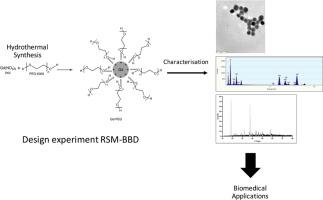Chinese Journal of Analytical Chemistry ( IF 1.2 ) Pub Date : 2023-09-26 , DOI: 10.1016/j.cjac.2023.100316 Santhy WYANTUTI , Balqis FADHILATUNNISA , Retna Putri FAUZIA , Qi JIA , Azmi Aulia RAHMANI , IRKHAM , Husein Hernadi BAHTI

|
Gadolinium (Gd) nanoparticles (NPs) are increasingly considered as a viable alternative to clinically employed Gd chelates in magnetic resonance imaging (MRI). The utilisation of these materials as contrast agents offers several advantages including lower toxicity, prolonged circulation time, and a sufficiently high Gd content, thereby enhancing disease imaging during MRI diagnosis. Therefore, this study synthesised Gd NPs using the hydrothermal method based on the response surface methodology Box-Behnken design (RSM-BBD) to determine the optimal conditions. In this experimental design, three independent variables, the mass of Gd2O3 (g), the synthesis temperature (°C) and time (h), were optimised to obtain sufficiently sized nanoparticles for further biomedical applications. In addition, polyethene glycol-6000 (PEG-6000) was used as a stabiliser to form uniformly sized nanoparticles. The optimal conditions were 0.4910 g of Gd2O3, a temperature of 180 °C, and a synthesis time of 7 h. Characterisation by scanning electron microscope-energy dispersive X-ray (SEM-EDX) and transmission electron microscope (TEM) demonstrated that the Gd NPs were spherical with a size range below 20 nm. Fourier transform infrared (FTIR) spectroscopy identified PEG molecules with low intensity on the Gd NPs and the obtained zeta potential value was +36.7±0.802 mV. The RSM-BBD analysis applied in this study facilitated the determination of the optimal synthesis conditions.
中文翻译:

响应面法 box-behnken 设计优化钆纳米粒子的水热合成
钆 (Gd) 纳米粒子 (NP) 越来越多地被认为是磁共振成像 (MRI) 中临床使用的 Gd 螯合物的可行替代品。使用这些材料作为造影剂具有多种优点,包括毒性较低、循环时间延长和足够高的Gd含量,从而增强MRI诊断过程中的疾病成像。因此,本研究采用基于响应面法Box-Behnken设计(RSM-BBD)的水热法合成Gd NPs,以确定最佳条件。在这个实验设计中,三个自变量,Gd 2 O 3的质量(g)、合成温度(°C)和时间(h)经过优化以获得足够尺寸的纳米颗粒用于进一步的生物医学应用。此外,聚乙二醇-6000(PEG-6000)用作稳定剂以形成尺寸均匀的纳米颗粒。最佳条件为0.4910 g Gd 2 O 3,温度180℃,合成时间7小时。扫描电子显微镜-能量色散X射线(SEM-EDX)和透射电子显微镜(TEM)表征表明Gd NPs呈球形,尺寸范围低于20 nm。傅里叶变换红外(FTIR)光谱鉴定了Gd NP上的低强度PEG分子,获得的zeta电位值为+36.7±0.802 mV。本研究中应用的 RSM-BBD 分析有助于确定最佳合成条件。



























 京公网安备 11010802027423号
京公网安备 11010802027423号